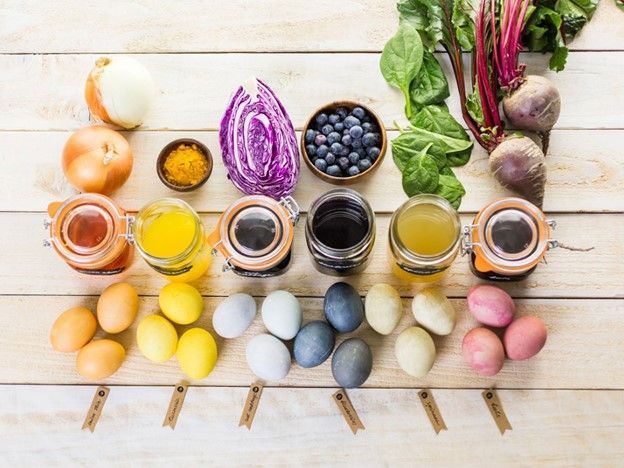Enjoying Outside, Inside - Natural Easter Egg Dyes

Naturally Dyed Easter Eggs (photo by Ariana Habich)
I’ve got a few decades worth of Easter egg dying under my belt and I still think it’s fun! We’ve experimented with all kinds of methods and processes including: crayons, shaving cream, glitter, jewels, oils and different dye kits but the one that brings back the most memories are those little fizzy tablets that you drop in a cup of hot water and a smidge of vinegar. Maybe it’s the smell of the hot vinegar that takes me back to my pink Easter basket and itchy dresses but it’s one tradition that I look forward to every year! I’ve learned that you can get make up your own colors that get more vibrant by using the food coloring in the spice aisle. We’ve even been dying brown eggs the past several years and get even more stunning colors.
This year we’re going to try making our own dye using fruits and vegetables from the garden, farmer’s market or the grocery store! The colors won’t be as vivid but I can’t wait to see the result. You’ll need hard-boiled eggs, white vinegar and an equal amount of quart size mason jars as you have colors.
There are two methods for making natural egg dyes, boiled and un-boiled. For the boiled method, give these coloring agents a try:
For purple use about 1 ½ cups of shredded red beets. For a golden rusty color use about seven yellow onion skins. For a sunny yellow color, use at least three tablespoons ground turmeric or cumin. For a sunset orange use three tablespoons chili powder. For a robin egg blue, use 1 ½ cups shredded purple cabbage. For a very light pea green try at least 1 ½ cups of spinach (honestly, this one isn’t the best color).
To make the boiled dyes bring two cups of water to a boil. Once you have a rolling boil, add your coloring agent and simmer at a low heat for at least 30 minutes, longer will give you a deeper, darker color. To check the intensity of the color you can dip the corner of a paper town into the liquid. Once you like it, strain the liquid into a mason jar and let cool for two to three hours or until it reaches room temperature. Then stir in two tablespoons of vinegar and add as many hard-boiled eggs as can be completely submerged by the liquid in the jar. If they aren’t completely submerged, your egg will look like when you miss a spot with the sunscreen. Cover and leave in the refrigerator overnight or until you like the color of the eggs.
Un-boiled dyes use juices or coffee for the coloring agent; if you’re using juices, do not dilute them, just plop your hard-boiled egg right into the jar with the juice or coffee. For a deep blue try using two cups of purple grape juice. For an even darker blue use two cups of 100% blueberry juice. And, for a brown try experimenting with different varieties of brewed coffee. Unless it’s chocolate though, I’m not really too sure who wants a brown Easter egg.
To add luster, you can put a thin coat of vegetable oil on the finished eggs and rub off the excess with a paper towel or napkin. Be sure to keep the eggs in the refrigerator until you’re ready to hunt for them or make that post-Easter egg salad sandwich.
Don’t forget to leave a carrot or two out for the Easter bunny the night before.
-Kristie Ehrhardt; kehrhardt@tuleyome.org
Tuleyome Land Conservation Program Manager
RECENT ARTICLES






